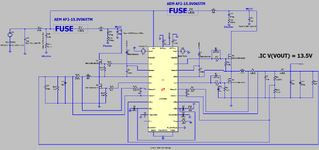cupoftea
Advanced Member level 5
Hi,
We have the attached 10.9A RMS current flowing in a 15A fuse.
Its at 450kHz.
The fuse is 2.16mm thick and surface mount.
Fuse part number is AF2-15.0V065TM
AF2-15.0V065TM Fuse
We calculated that the RAC/RDC is 5.1
Therefore the AC resistance of the fuse is 19.3mR (DC is 0.0038R)
As such, the power dissipation in it will be 2.9W.
Do you agree, this is way excessive. Do you agree, We must filter the current before it goes through
this fuse?
We have the attached 10.9A RMS current flowing in a 15A fuse.
Its at 450kHz.
The fuse is 2.16mm thick and surface mount.
Fuse part number is AF2-15.0V065TM
AF2-15.0V065TM Fuse
We calculated that the RAC/RDC is 5.1
Therefore the AC resistance of the fuse is 19.3mR (DC is 0.0038R)
As such, the power dissipation in it will be 2.9W.
Do you agree, this is way excessive. Do you agree, We must filter the current before it goes through
this fuse?

